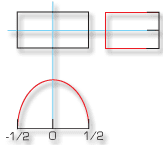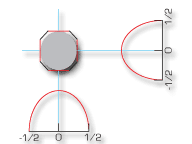Unique PEM Features
UNIQUE FEATURES OF THE PHOTOELASTIC MODULATOR
1. HIGH TRANSMISSION OF LIGHT –
When Hinds PEMs are used for polarization modulation, only the optical material is inserted into a linearly polarized beam. Hence, only the transmission property of the optical material used affects the light intensity loss during the modulation. It is generally easy to find a proper PEM to best fit the spectral region of interest regardless whether a laser or a white-band light source is used. Most Hinds PEM models have a transmission of >90% without anti-reflection (AR) coating. A transmission of >99% at a particular wavelength or over a specified spectral range can be achieved using AR coatings.
2. HIGH POWER HANDLING CAPABILITY –
The powerful lasers used in many laboratory set-ups require a high power handling capability on the part of a modulation device. Hinds PEMs have an excellent power handling rating which is estimated above 5 GW/cm2. Although the power handling ability degrades somewhat when AR coatings are used, Hinds PEMs are compatible with most laser systems.
3. WIDE SPECTRAL RANGE COVERAGE –
Over a dozen standard PEM models employing a variety of optical materials are available. Collectively, they cover the range from the vacuum UV to the mid-IR. These standard models utilize optical materials including fused silica (in various grades), CaF2, LiF, ZnSe, Si, etc. Often, more than one model will fit the spectral transmission requirements of a particular application. This wide spectral range characteristic is one of the most important advantages of Hinds PEMs. The ZnSe and CaF2 PEMs provide the best polarization modulation capability for the mid-IR region.
4. LARGE ACCEPTANCE ANGLE –
Since PEM optical elements are isotropic when no stress is applied (unlike Pockels cells and electro-optic modulators), Hinds PEMs have a large tolerance of the incident angle. There are two factors which affect the retardation of a light ray passing through the PEM. One is the path-length of the ray in the optical material, which increases as the incident angle becomes larger. The other is the decrease in the modulation efficiency when a ray is off-center of the PEM optical material. These two factors, though changing with optical materials, physical shapes and thickness of optical materials, are generally of the same order of magnitude. The compensation of these two effects makes the acceptance angle an order of magnitude larger than that of Pockels cells and electro-optic modulators. The PEM’s useful acceptance angle has been reported as large as +/- 40° by some researchers. The combination of large aperture and large acceptance angle makes Hinds PEMs particularly useful in polarization modulation applications where a large diameter and focusing beam is needed.
5. LARGE APERTURE –
Within the current working frequency range (20-100 kHz), Hinds PEMs are constructed with relatively large size optical elements. This results in large useful apertures for these PEMs. It is worth noticing that the modulation efficiency of our PEMs decreases as the light beam is moved away from the center of the optical element, as illustrated in the following figures for both the bar-shape and the octagonal-shape designs used in our PEMs.
BAR-SHAPE DESIGN

The modulation efficiency of the bar-shape PEMs is uniform in the vertical direction, but varies as a cosine function in the horizontal direction.
OCTAGONAL-SHAPE DESIGN

The modulation efficiency of the octagonal-shape PEMs varies as a cosine function along all directions from center of the optical element.
Notice that a “useful aperture” for a particular model PEM can only be defined according to the specific application. There are certain experiments that tolerate a relatively large non-uniformity of retardation over the useful aperture. For example, since a calibration procedure is generally needed, the variation of the modulation efficiency over the PEM aperture cancels out in a circular dichroism experiment. As a result, an aperture as large as 3/4 of what the whole optical element allows can be used.
Conversely, other experiments require a high uniformity of retardation over the useful aperture. Hinds PEMs can also be used for such experiments. Using the octagonal-shape PEMs, an aperture of 10% of the PEM optical element size will only give a <1% loss of average modulation efficiency. For such a small efficiency loss, the beam sizes range from several millimeters to several centimeters with different PEM models. For these experiments, relatively large size, octagonal-shape PEMs are preferred. For more information on Useful Aperture, please read this technical note:
6. HIGH SENSITIVITY FOR AN INTEGRATED INSTRUMENT –
The sensitivity of the entire instrument is determined by all the different components used. This includes the detector, the lock-in amplifier, the computer digital accuracy and other optical and electronic components. When a PEM is used as the key component for polarization modulation experiments, most instruments have a sensitivity higher than 10-6 , which implies that Hinds PEMs have at least this sensitivity. Some CD spectrometers using a PEM have a sensitivity at the order of 10-6 absorption unit.
7. DURABILITY –
Although constructed of fragile optics, Hinds PEMs are rugged and long-lasting. Most PEMs we made 20 years ago are still in current use.
8. FIXED FREQUENCY FOR POLARIZATION MODULATION –
Hinds PEMs are designed as a resonance device for polarization modulation at a fixed frequency. Different PEM models may have different working frequencies, but none of them are tunable. Hinds PEMs generate oscillating birefringence for polarization modulation purposes. They cannot be used as static wave-plates or isolators.
Contact us for more information on Hinds PEMs.